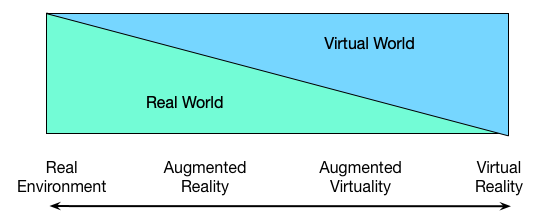New reality
Author: Clark
Go to Source
I’ve been looking into ‘realities’ (AR/VR/MR) for the upcoming Realities 360 conference (yes, I’ll be speaking). And I found an interesting model that’s new to me, and of course prompts some thoughts. For one, there’s a new reality that I hadn’t heard of! So, of course, I thought I’d share.
 The issue is how do AR (augmented reality) and VR (virtual reality) relate, and what is MR (mixed reality). The model I found (by Milgram, my diagram slightly relabels) puts MR in the middle between reality and virtual reality. And I like how it makes a continuum here.
The issue is how do AR (augmented reality) and VR (virtual reality) relate, and what is MR (mixed reality). The model I found (by Milgram, my diagram slightly relabels) puts MR in the middle between reality and virtual reality. And I like how it makes a continuum here.
So this is the first I have heard of ‘augmented virtuality’ (AV). AR is the real world with some virtual scaffolding. AV has more of the virtual world with a little real world scaffolding. A virtual cooking school in a real kitchen is an example. The virtual world guides the experience, instead of the real world.
The core idea to me is about story. If we’re doing this with a goal, what is the experience driver? What is pushing the goal? We could have a real task that we’re layering AR on top of to support success (more performance support than learning). In VR, we totally have to have a goal in the simulated world. AV strikes me as something that has a virtual world created story that uses virtual images and real locations. Kind of like The Void experience.
This reminded me of the Augmented Reality Games (ARGs) that were talked about quite a bit back in the day. They can be driven by media, so they’re not necessarily limited to locations. A colleague had built an engine that would allow experiences driven by communications technologies: text messages, email, phone calls, and these days we could add in tweets and posts on social media and apps. These, on principle, are great platforms for learning experiences, as they’re driven by the tools you’d actually use to perform. (When I asked my colleagues why they think they’ve ‘disappeared’, the reason was largely cost; that’s avoidable I believe.)
I like this continuum, as it puts ARGs and VR and AR in a conceptually clear framework. And, as I argue for extensively, good models give us principled bases for decisions and design. Here we’ve got a way to think about the relationship between story and technology that will let us figure out what makes the best approach for our goals. This new reality (and the others) will be part of my presentation next month. We’ll see how it manifests by then ;).
The post New reality appeared first on Learnlets.
